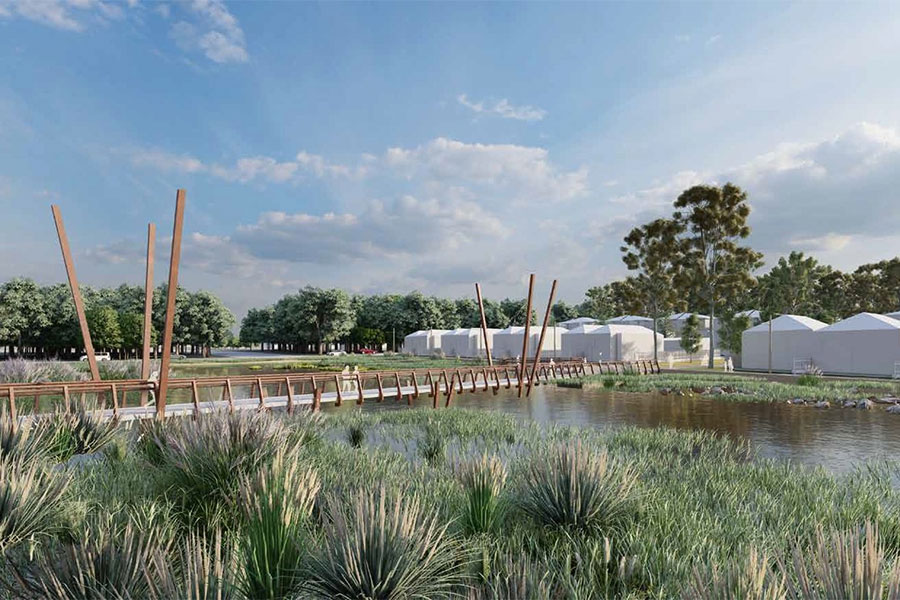Trees and green cover reduce urban temperatures directly through shading. Vegetation also releases moisture into the air through transpiration, helping us feel cooler.
According to a Macquarie University report, greening an area can reduce local land surface temperatures by up to 6°C.
Greening our urban areas creates liveable neighbourhoods, supports biodiversity in our cities, makes us feel more connected to nature and each other and improves our health and wellbeing.
How greening cools
Read how urban greening can create cooler places.
Retaining and providing tree canopy cover is one of the most effective ways to cool our urban areas. Mature and healthy tree canopy provides substantial shading and cooling benefits. Neighbourhoods and centres that feature streets with well-established avenues of trees, large trees on individual lots and established leafy open spaces are cooler places.
As we develop or redevelop urban areas, we need to provide sufficient space, water and soil with good drainage to allow trees to establish and maintain proper root and crown formation, stay healthy and reach their maximum cooling potential. It is important to select appropriate tree species that are suited to the space available and the local climate.
Where tree canopy is sparse, planting more trees will help protect communities from the effects of summer heat. Every 10% increase in tree cover can reduce land surface temperatures by more than 1°C. Strategically planning for the expansion of our local urban forests can maximise the cooling benefits of trees and green cover.
Diverse types of green cover, such as understorey planting and green roofs, walls and façades can complement the cooling benefits of tree canopy in areas or sites that have limited space to support trees. These types of green cover can be integrated with new buildings or retrofitted onto existing buildings and provide flexibility in landscape design and delivery.
Create green spaces to cool urban areas
Case studies
Read the case studies to understand how good greening practices have been implemented.
City of Sydney
To achieve a minimum canopy cover of 27% by 2050, the City of Sydney’s Urban Forest Strategy assessed capacity for tree planting on streets, parks and properties to identify priorities and specific locations for increasing canopy cover.
Camden Council
Camden Council’s Urban Forest Strategy 2023 analysed urban heat and heat vulnerability data. It found that newer residential areas experienced higher temperatures than older, established suburbs with more tree canopy. One of the strategy’s objectives is to increase canopy cover and green cover across Camden, prioritising areas of low canopy and high vulnerability to urban heat. The development of the strategy was funded by the NSW Government under the Greener Neighbourhoods program in 2022.
Fairfield City Council
Fairfield City Council’s Street Tree Master Plan identifies priorities for street tree plantings to maximise the benefits to people and create healthy and diverse landscapes across Fairfield City. The development of the masterplan was funded by the NSW Government under the Greener Neighbourhoods program in 2022.
Austral
At Austral, Landcom is focusing on providing greener, cooler streets. Austral is a greenfield site that will be characterised by low- to medium-density development.
Landcom is supporting community resilience to heat by leveraging the neighbourhood’s proximity to the Western Sydney Parklands.
The design integrates the precinct into the Southwestern Sydney Green Grid, which aims to connect a network of public open spaces to town centres, transport hubs and residential areas.
Greener streets for better quality of life
Landcom’s strong focus on tree planting is a direct response to the extreme heat conditions that western Sydney faces. During heatwaves, temperatures can be 6°C to 10°C higher than in eastern Sydney.
By prioritising the planting of 620 new trees, Austral will achieve up to 50% canopy cover on its streets. The increased tree cover has been achieved by reducing carriage way width and creating wider verges. The distance between trees has been reduced to provide a more continuous canopy.
Landcom will strategically plant trees in shared zones to maximise their cooling effect, providing shade, fostering social cohesion and enhancing opportunities for water-sensitive urban design.
Landcom’s analysis shows that the planting strategy could reduce ambient temperatures by up to 6°C during summer.
Other strategies Landcom will use include keeping mature trees, increasing soft landscaping and promoting urban gardens. These all work together to reduce heat-absorbing hard surfaces.
Kemps Creek will run through the centre of the precinct. Landcom’s planting and greening strategy will enhance this blue-green corridor through the centre of the community and bring landscaping together with stormwater management. Research suggest that combined blue-green infrastructure has the greatest cooling effect. By increasing tree canopy and integrating green and blue spaces, Landcom is creating cooler places and improving the quality of life for the Austral community.
To read more about Landcom's Sustainable Places Strategy Case Study, visit Using planning strategies and controls for cooling.


